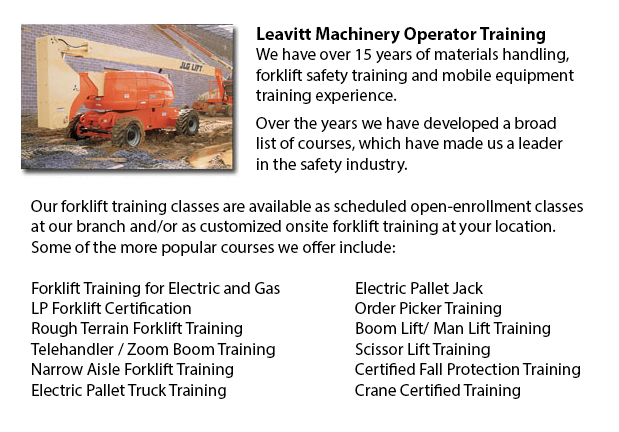
Markham Aerial Lift Safety Training - Every year, there are about 26 construction fatalities due to the utilization of aerial lifts. Nearly all of the craftsmen killed are electrical workers, laborers, carpenters, painters or ironworkers. The majority of the fatalities are caused by tip-overs, electrocutions and falls. The greatest risk is from boom-supported lifts, like for instance cherry pickers and bucket trucks. The majority of the deaths are related to this kind of lift, with the rest involving scissor lifts. Other dangers consist of being struck by falling objects, being thrown out of a bucket, and being caught between the guardrail or lift bucket and an object, such as a steel beam or joist.
The safe operation of an aerial lift needs a check on the following things prior to using the device: emergency and operating controls, personal fall protection gear, safety devices, and tires and wheels. Look for possible leaks in the air, fuel-system, hydraulic fluid. Check the device for missing or loose parts.
The areas that worker would use the aerial device should be inspected carefully for potential dangers, like bumps, holes, debris and drop-offs. Overhead powerlines have to be avoided and monitored. It is suggested that aerial lift devices be used on surfaces that are stable and level. Do not work on steep slopes which go beyond slope restrictions specified by the manufacturer. Even on a level slope, wheel chocks, outriggers and brakes must be set.
Companies must provide their aerial lift operators with the correct manuals. Mechanics and operators have to be trained by a licensed individual experienced with the relevant kind of aerial lift.
Aerial Lift Safety Guidelines:
o Prior to operating, close lift platform chains and doors.
o Climbing on and leaning over guardrails is prohibited. Stand on the floor of the bucket or platform.
o Stay within manufacturer's load-capacity restrictions.
o Use work-zone warnings, like for instance signs and cones, when working near traffic.
Electrocutions are avoidable if safety procedures are followed. Stay as far away from power lines - at least 10 feet. Skilled electrical workers should de-energize and/or insulate power lines. Workers should make use of personal protective tools and equipment, like for example insulated bucket. Then again, a bucket that is insulated does not protect from electrocution if, for instance, the worker touches another wire providing a path to the ground.
Falls are preventable if the person working remains secure in guardrails or inside the bucket by using a full-body harness or a positioning device. If there is an anchorage inside the bucket, a positioning belt with a short lanyard is acceptable.
By following the manufacturer's instructions, tip-overs can be avoided. Never drive the lift platform when it is elevated, unless the manufacturer specifies otherwise. Follow the device's vertical and horizontal reach restrictions, and never exceed the specified load-capacity.
-
Markham Forklift Certification Schools
Markham Forklift Certification Schools - Forklift Certification is mandatory in North America. Hence, forklift training programs are essential both for businesses and for people seeking jobs in industries as forklift operators. Forklift training focu... More -
Telehandler Training in Markham
Telescopic handlers normally called telehandlers for short, are a very popular piece of heavy construction equipment. They are commonly utilized in the construction and agricultural trades. These machines have maximum reaching capability and can get... More -
Markham Zoom Boom Training
Markham Zoom Boom Training - Zoom Boom Training is designed to train operators on variable reach forklifts. The objectives of the training are to impart an understanding of the physics of the machinery, and to outline the operator's tasks. This progr... More -
Markham Heavy Equipment Ticket
Markham Heavy Equipment Ticket - A heavy equipment operator will utilize different construction machinery, depending upon the nature of the task at hand. The large equipment are constructed to carry out specific tasks in the most efficient method for... More -
Markham Scissor Lift Training
Markham Scissor Lift Training - When operating a scissor lift, they must be utilized competently so as to protect the safety of the other employees inside the workplace and to protect the safety of the machine. Competent operators are trained to driv... More -
Markham Manlift Operator Training
Markham Manlift Operator Training - The aerial lift or manlift is a specialized kind of hydraulic platform which is designed to raise a person vertically giving it an alternate name of a vertical personnel lift. These machines are widely used for a m... More -
Markham Heavy Equipment Training
Markham Heavy Equipment Training - The two most common kinds of heavy equipment training are classed into the categories of machinery; equipment that is fashioned with tracks and those with rubber tires. The tracked vehicle are heavy duty equipment s... More -
Markham Forklift Safety Training
Markham Forklift Safety Training - Those wanting work in industries that utilize forklifts should undergo a forklift safety training course before becoming a certified operator of a forklift. There are various ways to go about getting forklift safety... More

Forklift Certification Markham
TOLL FREE: 1-888-254-6157
Markham, Ontario
forkliftcertificationmarkham.com
Email Us
About Us


